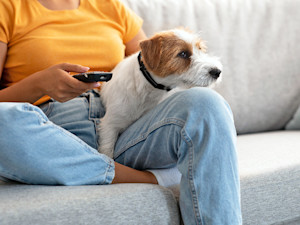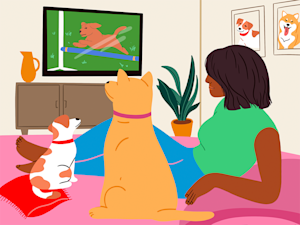Dogs Have Different TV Preferences Depending on Their Personalities, New Study Finds
Does your pup want you to leave on Love Island or Stranger Things?

Share Article
If you’ve ever enjoyed some TV time with your dog (and if you haven’t, you’re in the minority), you may have noticed they quite often seem to have some strong opinions about what’s on screen. Maybe your more refined dog has their ears perked up when Downton Abbey is on, but trots away when you switch to Love Island — while your fun-loving pup snoozes through Westworld and can’t turn away from reruns of The Simpsons. It’s possible that you’re not making it up. A new studyopens in new tab found that a dog’s personality plays a role in what kind of TV they prefer.
First of all, yes, dogs really do watch TV, and previous studies have found that they have some strong preferences. For one, dogs pay more attention to TVopens in new tab that includes humans and other dogs — types of stimuli that are relevant to their own lives. We also know that blue and yellow hues are more likely to grab a dog’s attention, thanks to their unique eyesight. But most of these findings are about dogs in general, rather than dogs as individuals — and as any Real Housewives super-fan who’s tried to have a night in with a Sopranos super-fan can tell you, that intraspecies variance matters a whole lot.
For the new study, researchers analyzed the viewing habits of 453 dogs whose pet parents say their pups regularly watch television. Pet parents rated the frequency that their dogs reacted to seeing four categories of stimuli: dogs, non-dog household pets, non-household animals, humans, and inanimate objects. Reactions might include barking, wagging their tail, or changing their body posture. Similarly, the dog’s guardians rated how often they responded to auditory stimulus: dog noises, non-dog household pet noises, non-household animal noises, human noises, inanimate object noises, and weather noises.
Researchers found that, generally, dogs are more likely to react to seeing other animals on screen than any other stimuli — 45 percent of dogs consistently responded to dog noises such as howling or barking. But how they reacted to the stimuli varied depending on the dog’s natural temperament.
Dogs who were reported as excitable were more likely to follow objects offscreen, as if they existed in real life. On the other hand, when it came to auditory stimulus, “dogs who displayed more fearful tendencies were more likely to respond to the non-animal stimuli,” such as doorbells and car horns, wrote Lane I. Montgomery, the study’s lead author. What’s gripping pups — or freaking them out — varies depending on their own dispositions and preferences.
The researchers added that these findings are important for knowing how to keep our pups feeling happy and secure — and they prove that just as it does for humans, TV can play a significant role in a dog’s emotional state. “This study informs towards the use of television as a welfare intervention, as well as dogs’ perceptual evaluations of artificial visual and auditory stimuli,” Montgomery concluded. “Overall, this study indicates that companion dogs experience a meaningful, object-filled world when they view television.”

Sio Hornbuckle
Sio Hornbuckle is the Assistant Editor at Kinship, where they frequently write for the site. As a writer, they specialize in pet news, animal science, and pop culture. They live in New York City with their cat, Toni Collette.
Related articles
![Woman watching tv with her dog at home.]()
Watching TV Is the Activity People Most Enjoy Doing With Their Dogs, New Survey Finds
But is it their dogs?
![Woman sitting on couch with dog laying on lap watching TV]()
What Dogs See When They Watch TV
Is Animal Planet really their favorite channel?
Why Do Dogs Watch TV?
Yes, pups can be couch potatoes, just like their parents.
![woman watching TV with her dogs]()
Dogs Love to Watch TV, New Study Says—But Should You Let Them?
Time for some screen-time ground rules, pups.
Are Dogs Color Blind? How Do We Know What Colors Dogs Can See?
It’s not all black and white.




